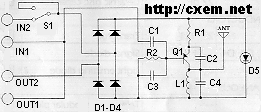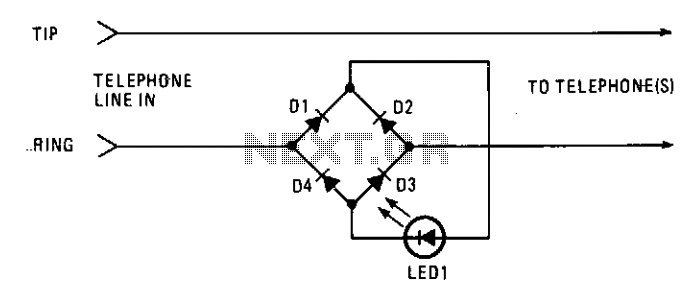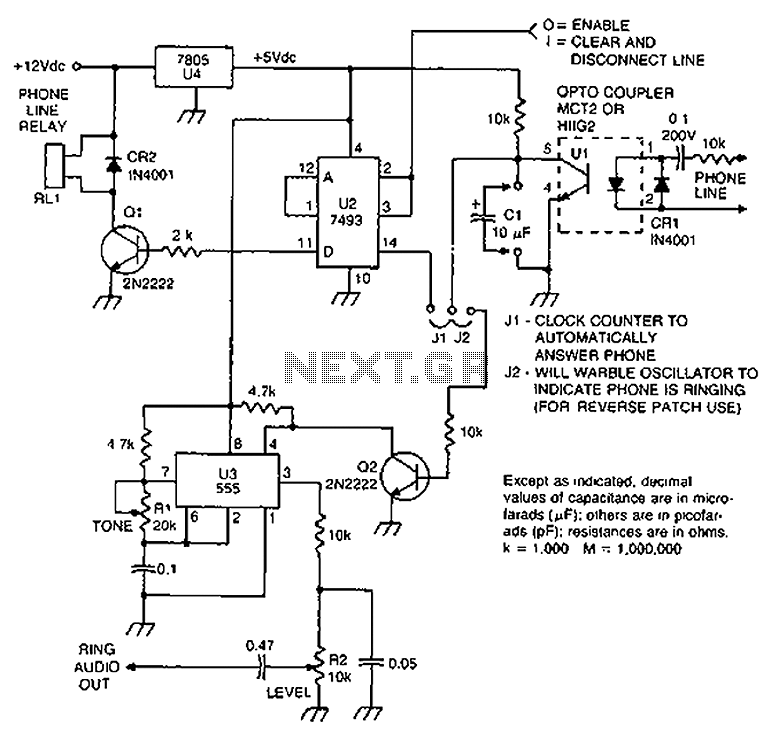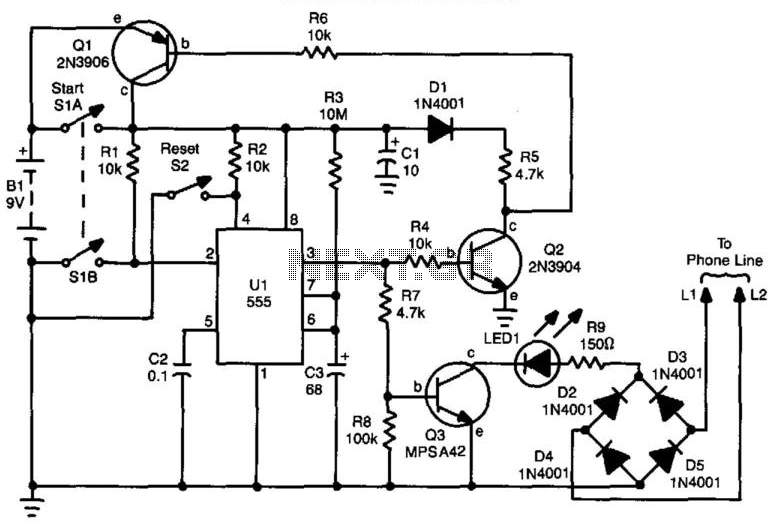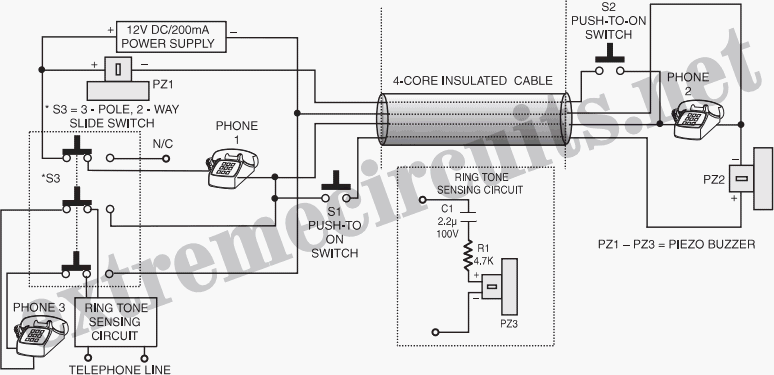
9-Line Telephone Sharer

This circuit can manage nine independent telephones using a single telephone line pair, located up to 100 meters apart for making and receiving calls while ensuring conversation privacy. It is particularly useful for multiple members residing in different rooms or apartments who share a single telephone line. Typically, connecting nine phones in parallel results in all phones ringing simultaneously, which can lead to confusion as eight out of nine users may realize the call is not intended for them. Additionally, this setup allows for the potential of overhearing conversations, which is undesirable. The proposed circuit addresses these issues by ensuring that the ring signal is heard only at the intended extension, for instance, extension number 1. To utilize this feature, the calling party must first dial the normal phone number of the recipient. Once the call is connected, no ring-back tone is heard by the caller. The caller then needs to press the asterisk (*) button on their phone to switch to tone mode (if the phone operates in dial mode) and dial the desired extension number, such as 1, within 10 seconds. If the caller does not dial the extension within this timeframe, the line will automatically disconnect. Furthermore, if the dialed extension phone is not picked up within 10 seconds, the ring-back tone will stop. The ring signal on the main phone line is detected by the opto-coupler MCT-2E (IC1), which activates a 10-second timer formed by IC2 (555) and energizes relay RL10 (6V, 100-ohm, 2 C/O). One of the normally open contacts of the relay connects the +6V rail to the processing circuitry, while the other provides a 220-ohm loop resistance to deactivate the ringer relay in the telephone exchange, thus stopping the ring. When the caller dials the extension number in tone mode, the tone receiver CM8870 (IC3) outputs the code 0001, which is sent to the 4-bit BCD-to-10 line decimal decoder IC4 (CD4028). The output from IC4 at pin 14 (Q1) goes high, activating the SCR (TH-1) and the associated relay RL1. Relay RL1 connects the 50Hz extension ring signal, derived from the 230V AC mains, to the telephone line of extension 1. This ring signal is exclusive to telephone 1, as half of the signal is blocked by diode D1 and DIAC1, which do not conduct below 35 volts.
The circuit design employs a robust architecture to facilitate seamless communication across multiple extensions while preserving privacy. The use of an opto-coupler (MCT-2E) allows for electrical isolation, enhancing safety and reliability by preventing high voltages from affecting the low-voltage components. The 555 timer (IC2) is configured in monostable mode, providing a precise timing function to manage the call duration and ensure that the system operates within the defined 10-second window for dialing the extension.
The relay (RL10) serves a dual purpose: it powers the processing circuitry and interrupts the ringing signal to prevent unwanted interruptions. The integration of the tone receiver (CM8870) with the BCD decoder (CD4028) ensures that only the intended extension receives the ring signal, effectively eliminating the risk of cross-talk and ensuring that users can communicate without the fear of eavesdropping.
Relay RL1's activation connects the 50Hz ringing signal to the designated telephone line, ensuring that only the intended recipient is alerted to the incoming call. The design cleverly uses a diode (D1) and a DIAC (DIAC1) to create a voltage threshold that prevents other extensions from receiving the ringing signal, further enhancing the privacy aspect of the circuit. Overall, the schematic provides a sophisticated solution for managing multiple telephone extensions efficiently while maintaining user confidentiality.This circuit is able to handle nine independent telephones (using a single telephone line pair) located at nine different locations, say, up to a distance of 100m from each other, for receiving and making outgoing calls, while maintaining conversation secrecy. This circuit is useful when a single telephone line is to be shared by more members resi ding in different rooms/apartments. Normally, if one connects nine phones in parallel, ring signals are heard in all the nine telephones (it is also possible that the phones will not work due to higher load), and out of nine persons eight will find that the call is not for them. Further, one can overhear others` conversation, which is not desirable. To overcome these problems, the circuit given here proves beneficial, as the ring is heard only in the desired extension, say, extension number 1`.
For making use of this facility, the calling subscriber is required to initially dial the normal phone number of the called subscriber. When the call is established, no ring-back tone is heard by the calling party. The calling subscriber has then to press the asterik (*) button on the telephone to activate the tone mode (if the phone normally works in dial mode) and dial extension number, say, 1`, within 10 seconds.
(In case the calling subscriber fails to dial the required extension number within 10 seconds, the line will be disconnected automatically. ) Also, if the dialed extension phone is not lifted within 10 seconds, the ring-back tone will cease.
The ring signal on the main phone line is detected by opto-coupler MCT- 2E (IC1), which in turn activates the 10-second on timer`, formed by IC2 (555), and energises relay RL10 (6V, 100- ohm, 2 C/O). One of the N/O` contacts of the relay has been used to connect +6V rail to the processing circuitry and the other has been used to provide 220-ohm loop resistance to deenergise the ringer relay in telephone exchange, to cut off the ring.
When the caller dials the extension number (say, 1`) in tone mode, tone receiver CM8870 (IC3) outputs code 0001`, which is fed to the 4- bit BCD-to-10 line decimal decoder IC4 (CD4028). The output of IC4 at its output pin 14 (Q1) goes high and switches on the SCR (TH-1) and associated relay RL1.
Relay RL1, in turn, connects, via its N/O contacts, the 50Hz extension ring signal, derived from the 230V AC mains, to the line of telephone 1`. This ring signal is available to telephone 1` only, because half of the signal is blocked by diode D1 and DIAC1 (which do not conduct below 35 volts).
🔗 External reference
The circuit design employs a robust architecture to facilitate seamless communication across multiple extensions while preserving privacy. The use of an opto-coupler (MCT-2E) allows for electrical isolation, enhancing safety and reliability by preventing high voltages from affecting the low-voltage components. The 555 timer (IC2) is configured in monostable mode, providing a precise timing function to manage the call duration and ensure that the system operates within the defined 10-second window for dialing the extension.
The relay (RL10) serves a dual purpose: it powers the processing circuitry and interrupts the ringing signal to prevent unwanted interruptions. The integration of the tone receiver (CM8870) with the BCD decoder (CD4028) ensures that only the intended extension receives the ring signal, effectively eliminating the risk of cross-talk and ensuring that users can communicate without the fear of eavesdropping.
Relay RL1's activation connects the 50Hz ringing signal to the designated telephone line, ensuring that only the intended recipient is alerted to the incoming call. The design cleverly uses a diode (D1) and a DIAC (DIAC1) to create a voltage threshold that prevents other extensions from receiving the ringing signal, further enhancing the privacy aspect of the circuit. Overall, the schematic provides a sophisticated solution for managing multiple telephone extensions efficiently while maintaining user confidentiality.This circuit is able to handle nine independent telephones (using a single telephone line pair) located at nine different locations, say, up to a distance of 100m from each other, for receiving and making outgoing calls, while maintaining conversation secrecy. This circuit is useful when a single telephone line is to be shared by more members resi ding in different rooms/apartments. Normally, if one connects nine phones in parallel, ring signals are heard in all the nine telephones (it is also possible that the phones will not work due to higher load), and out of nine persons eight will find that the call is not for them. Further, one can overhear others` conversation, which is not desirable. To overcome these problems, the circuit given here proves beneficial, as the ring is heard only in the desired extension, say, extension number 1`.
For making use of this facility, the calling subscriber is required to initially dial the normal phone number of the called subscriber. When the call is established, no ring-back tone is heard by the calling party. The calling subscriber has then to press the asterik (*) button on the telephone to activate the tone mode (if the phone normally works in dial mode) and dial extension number, say, 1`, within 10 seconds.
(In case the calling subscriber fails to dial the required extension number within 10 seconds, the line will be disconnected automatically. ) Also, if the dialed extension phone is not lifted within 10 seconds, the ring-back tone will cease.
The ring signal on the main phone line is detected by opto-coupler MCT- 2E (IC1), which in turn activates the 10-second on timer`, formed by IC2 (555), and energises relay RL10 (6V, 100- ohm, 2 C/O). One of the N/O` contacts of the relay has been used to connect +6V rail to the processing circuitry and the other has been used to provide 220-ohm loop resistance to deenergise the ringer relay in telephone exchange, to cut off the ring.
When the caller dials the extension number (say, 1`) in tone mode, tone receiver CM8870 (IC3) outputs code 0001`, which is fed to the 4- bit BCD-to-10 line decimal decoder IC4 (CD4028). The output of IC4 at its output pin 14 (Q1) goes high and switches on the SCR (TH-1) and associated relay RL1.
Relay RL1, in turn, connects, via its N/O contacts, the 50Hz extension ring signal, derived from the 230V AC mains, to the line of telephone 1`. This ring signal is available to telephone 1` only, because half of the signal is blocked by diode D1 and DIAC1 (which do not conduct below 35 volts).
🔗 External reference
